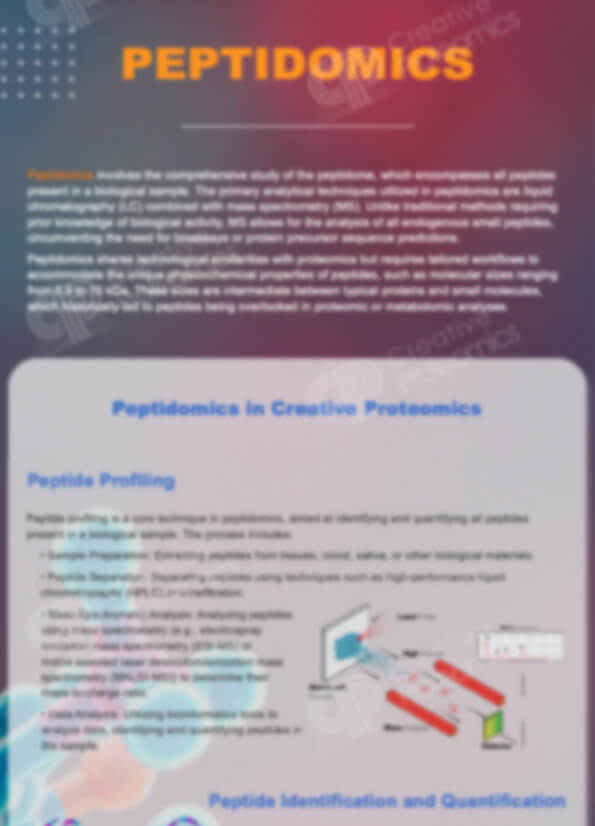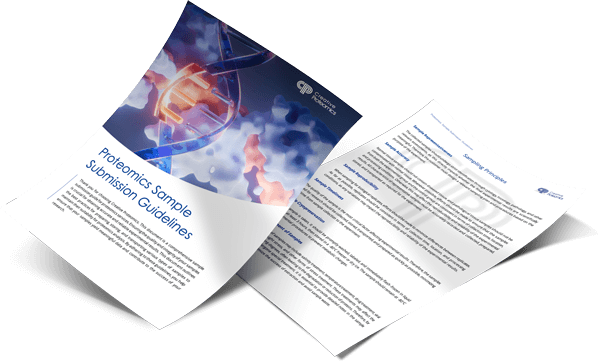Overview of Peptidomics Services
High sensitivity,high throughput and high specificity for peptides qualitative and quantitative.
Submit Your Request Now
×- What Is Peptidomics
- Peptidomics Serives
- Platforms
- Workflow
- Applications
- Demo
- FAQs
- Case
- Why Creative Proteomics
- Sample Requirements
What Is Peptidomics
Peptidomics is defined as a systematic, comprehensive, qualitative/quantitative multiplex analysis of endogenous peptides (up to ~20 kDa) in biological samples collected at a chosen time point and location. Peptidomics served as a complement strategy to bridge the gap between proteomics and metabolomics. The invaluable information can be obtained from studies of the numerous soluble polypeptides, including signaling molecules (such as cytokines, growth factors, and peptide hormones), and other small protein fragments and peptides of undetermined functions likely from disease-specific proteolytic cleavage. Peptidomics analysis has shed light on protein synthesis, processing, degradation, and their regulation under various physiological and pathological conditions. Additionally, it influences gene expression, substance metabolism, and other processes. Hence, peptidomics is regarded as a crucial link connecting proteomics and metabolomics.
 Schulz-Knappe, et.al. (2001). Peptidomics: the comprehensive analysis of peptides in complex biological mixtures.
Schulz-Knappe, et.al. (2001). Peptidomics: the comprehensive analysis of peptides in complex biological mixtures.
Peptidomics Analysis at Creative Proteomics
Mass spectrometry and bioinformatic analysis make the proteomics and peptidomics analysis possible. The detected peptides are identified via de novo sequencing, or database searching by tandem mass spectrometers.
Service Contents
- Characterization of Peptide Biomarker
- Untargeted Peptidomics
- Immunopeptidomics
Characterization of Peptide Biomarker
Peptides are widely involved in biological process which turns to be ideal biomarker candidates.
Untargeted Peptidomics
untargeted peptidomics is an enabling tool to measure global protein abundances and new peptides.
Immunopeptiomics plays a crucial role in identifying and quantifying immune peptides presented by the cell surface major histocompatibility complex (MHC) of the immune system.
Comprehensive Peptidomics Service
The aim of comprehensive peptidomics, is not only to identify and validate all endogenous peptides in a biological sample under investigation, but also to compare expression levels of the peptides of interest for specific biochemical processes. Thus, the unbiased identification of biologically interesting peptides became possible with the aid of mass spectrometry, rather than a ligand binding assay.
 Workflow of the comprehensive peptidomics
Workflow of the comprehensive peptidomics
Although peptidomics and proteomics share many of the same general objectives and techniques in research strategies, there are still several major differences. Enzymes of digestive specificity are usually not applied in peptidomics studies so that the native peptides can be identified, including any post-translational modifications, with MS and MS/MS.
With the emergence and advancement of MS/MS sequencing technique, MS-based peptide identification has largely replaced the conventional sequencing assay, Edman degradation. A number of studies have used mass spectrometry to examine peptides invarious tissue extracts. Typical peptidomics studies are focused on bioactive peptides.
By removing most of the proteins in biological samples, body fluids and tissue extracts, with size exclusion chromatography, LC-MS based method can be quickly developed and validated for peptide identification with high accuracy and reproducibility. After comprehensive and detailed discussion with the clients, Creative Proteomics can provide customer-tailored analytical service in peptidomic researches.
Technical Platforms
See more Creative Proteomics Mass Spectrometry
The targeted metabolomics service provided by Creative Proteomics is based on our cutting edge separation and analytical platforms. Our experienced technicians have optimized protocols, in order to provide best service to meet customers' requirement.
Workflow of Peptidomics analysis
 The process of peptidomics analysis (Tinoco, A. D. et al; 2011)
The process of peptidomics analysis (Tinoco, A. D. et al; 2011)
Key Steps in Peptidomics Analysis
Peptidomics analysis is a powerful technique for investigating the structure, function, and regulation of peptides within proteins, offering insights into protein functions and mechanisms. The process typically includes the following steps:
1. Protein Extraction and Digestion: Proteins are first isolated and separated using techniques like filtration, gel-chromatography, precipitation or isoelectric focusing. They are then subjected to enzymatic digestion, often with trypsin, which cleaves proteins at lysine and arginine sites, generating peptides suitable for further analysis.
2. Mass Spectrometry Analysis: The generated peptides are ionized and analyzed using mass spectrometry techniques such as LC-MS or GC-MS. These methods measure the mass-to-charge ratio and sequence of the peptides by separating them based on their molecular properties.
3. Data Processing and Protein Identification: The data obtained from mass spectrometry is processed using specialized software (e.g., PEAKS、Mascot、pFind、MaxQuant) to match peptide sequences with known protein databases, allowing for the identification of the originating proteins.
4. Quantification: Peptide abundance is quantified using either labeling techniques, such as TMT or iTRAQ, or label-free methods, which compare the intensity of mass spectrometry signals across samples.
5. Biological Interpretation: The resulting data is analyzed to uncover insights into protein dynamics, post-translational modifications, protein interactions, and signaling pathways, which are crucial for understanding disease mechanisms and discovering potential biomarkers.
Appliacations of Peptidomics




Disease State Analysis and Biomarker Discovery
Peptidomics reveals amino acid sequences, enabling biomarker discovery, disease analysis, drug efficacy evaluation, and toxicity assessment with high sensitivity.
Detection of Endogenous Peptides
Peptidomics also focuses on detecting endogenous peptides, particularly neuropeptides, which function as neurotransmitters, hormones, or neuromodulators in the body.
Food Processing
Peptidomics is instrumental in studying peptides released during food processing, particularly in dairy products.
Drug Discovery
Advanced techniques enable precise peptide identification, synthesis, and development, facilitating targeted therapeutic applications and enhancing active peptide discovery.
Demo for Peptidomics Services
Figures come from ( Shibata, H.et.al, J Clin Immunol,2024)
Peptidomics FAQs
Can peptides be quantitatively detected?
Yes, quantitative detection can be achieved through peptidomics. Peptidomics encompasses the comprehensive study of endogenous peptides in biological tissues or fluids. It investigates the structure, function, variations, and associated relationships of endogenous peptides and low-molecular-weight proteins within the organism. The distinction between peptides and proteins is not always clear-cut. Generally, proteins with a molecular weight below 10 kDa are considered peptides. In peptidomics, detection typically focuses on peptide sequences containing six or more amino acids.
How does the experimental workflow of peptidomics differ from conventional proteomics?
In peptidomics, there is a distinct step after sample pre-processing involving the separation and enrichment of peptides. Unlike conventional proteomics, peptidomics does not incorporate a quality control process.
Can small peptides with 2-4 amino acids be detected using peptidomics? What is the range of peptide lengths that peptidomics can detect?
No, small peptides with 2-4 amino acids cannot be detected using peptidomics. Peptidomics typically focuses on peptides with a length of 6 amino acids or more (commonly in the range of 6-80 amino acids). Peptidomics defaults to the detection of peptides with a molecular weight smaller than 10 kDa.
What is the difference between peptidomics and proteomics?
Peptidomics is a branch of proteomics that focuses on low-molecular-weight (i.e., < 50–100 amino acids, < 3 kDa) polypeptides/peptides in biological samples and was first described in 2000 years.
Peptidomics Case study
Why Creative Proteomics?
- Efficiency: Gentle sample extraction preserves the natural state of peptides, ensuring their authenticity.
- High Sensitivity: Leveraging high-resolution mass spectrometry, it offers excellent sensitivity and reproducibility.
- Versatility: It enables the identification of both known and unknown peptide sequences, facilitating the discovery of novel active peptides.
- Effectiveness: Enhancing the efficiency of endogenous peptide extraction from samples.
- High Throughput: Simultaneously studying endogenous peptides across multiple samples.
- High Specificity: Independent of antibodies, minimizing cross-reactivity concerns.
- Qualitative and Quantitative: Simultaneously performing sequence identification and quantitative analysis of multiple peptides.
- Efficient enrichment efficiency: more than 99% of the protein is removed during sample processing.
- Comprehensive service capability: simultaneously providing reliable peptide and proteomic data with corresponding bioinformatics analysis.
Sample Requirements
| Sample type | Recommended sample size | |
|---|---|---|
| Animal tissues | Hard tissues (bones, hair) | 300-500mg |
| Soft tissues (leaves, flowers of woody plants, herbaceous plants, algae, ferns) | 200mg | |
| Plant tissues | Hard tissues (roots, bark, branches, seeds, etc.) | 3-5g |
| Microbes | Common bacteria, fungal cells (cell pellets) | 100μL |
| cells | Suspension/adherent cultured cells (cell count/pellet) | >1*107 |
| Fluids | Plasma/serum/cerebrospinal fluid (without depletion of high abundance proteins) | 20μL |
| Plasma/serum/cerebrospinal fluid (with depletion of high abundance proteins) | 100μL | |
| Follicular fluid | 200μL | |
| Lymph, synovial fluid, puncture fluid, ascites | 5mL | |
| Others | Saliva/tears/milk | 3-5mL |
| Culture supernatant (serum-free medium cannot be used) | 20mL | |
| Pure protein (best buffer is 8MUrea) | 300μg | |
| FFPE | Each slice: 10µm thickness, 1.5×2cm area | 15-20 slices |
References
- Schulz-Knappe, P et al. "Peptidomics: the comprehensive analysis of peptides in complex biological mixtures." Combinatorial chemistry & high throughput screening vol. 4,2 (2001): 207-17.
- Hartman, Erik et al. "Bioinformatic Analysis of the Wound Peptidome Reveals Potential Biomarkers and Antimicrobial Peptides." Frontiers in immunology vol. 11 620707. 3 Feb. 2021
- Shibata, Hirofumi et al. "A Non-targeted Proteomics Newborn Screening Platform for Inborn Errors of Immunity." Journal of clinical immunology vol. 45,1 33. 25 Oct. 2024.


























